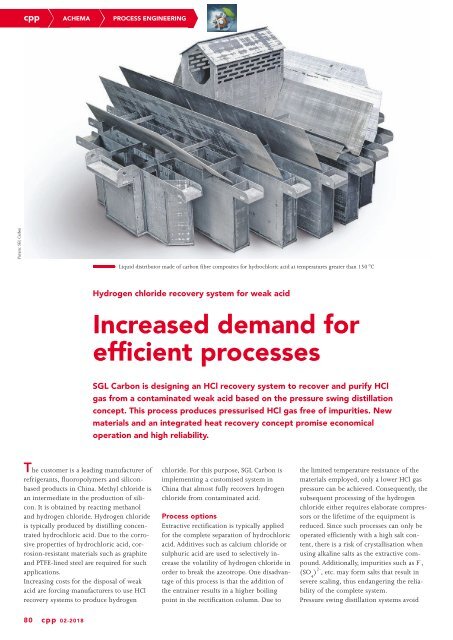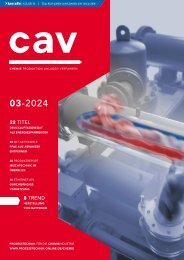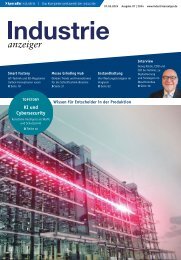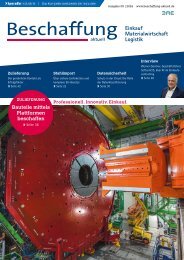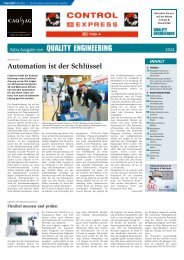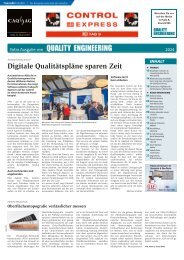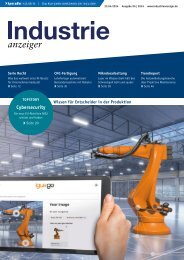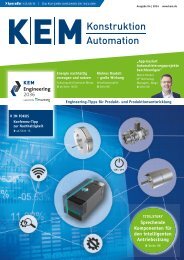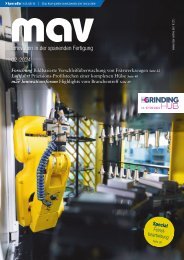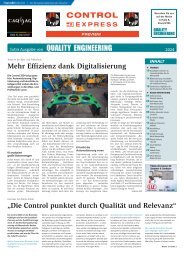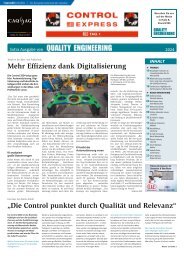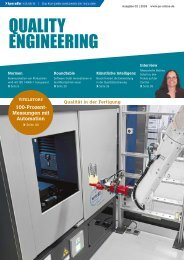cpp - Process technology for the chemical industry 02.2018
You also want an ePaper? Increase the reach of your titles
YUMPU automatically turns print PDFs into web optimized ePapers that Google loves.
<strong>cpp</strong> ACHEMA PROCESS ENGINEERING<br />
Pictures: SGL Carbon<br />
Liquid distributor made of carbon fibre composites <strong>for</strong> hydrochloric acid at temperatures greater than 150 °C<br />
Hydrogen chloride recovery system <strong>for</strong> weak acid<br />
Increased demand <strong>for</strong><br />
efficient processes<br />
SGL Carbon is designing an HCl recovery system to recover and purify HCl<br />
gas from a contaminated weak acid based on <strong>the</strong> pressure swing distillation<br />
concept. This process produces pressurised HCl gas free of impurities. New<br />
materials and an integrated heat recovery concept promise economical<br />
operation and high reliability.<br />
The customer is a leading manufacturer of<br />
refrigerants, fluoropolymers and siliconbased<br />
products in China. Methyl chloride is<br />
an intermediate in <strong>the</strong> production of silicon.<br />
It is obtained by reacting methanol<br />
and hydrogen chloride. Hydrogen chloride<br />
is typically produced by distilling concentrated<br />
hydrochloric acid. Due to <strong>the</strong> corrosive<br />
properties of hydrochloric acid, corrosion-resistant<br />
materials such as graphite<br />
and PTFE-lined steel are required <strong>for</strong> such<br />
applications.<br />
Increasing costs <strong>for</strong> <strong>the</strong> disposal of weak<br />
acid are <strong>for</strong>cing manufacturers to use HCl<br />
recovery systems to produce hydrogen<br />
chloride. For this purpose, SGL Carbon is<br />
implementing a customised system in<br />
China that almost fully recovers hydrogen<br />
chloride from contaminated acid.<br />
<strong>Process</strong> options<br />
Extractive rectification is typically applied<br />
<strong>for</strong> <strong>the</strong> complete separation of hydrochloric<br />
acid. Additives such as calcium chloride or<br />
sulphuric acid are used to selectively increase<br />
<strong>the</strong> volatility of hydrogen chloride in<br />
order to break <strong>the</strong> azeotrope. One disadvantage<br />
of this process is that <strong>the</strong> addition of<br />
<strong>the</strong> entrainer results in a higher boiling<br />
point in <strong>the</strong> rectification column. Due to<br />
<strong>the</strong> limited temperature resistance of <strong>the</strong><br />
materials employed, only a lower HCl gas<br />
pressure can be achieved. Consequently, <strong>the</strong><br />
subsequent processing of <strong>the</strong> hydrogen<br />
chloride ei<strong>the</strong>r requires elaborate compressors<br />
or <strong>the</strong> lifetime of <strong>the</strong> equipment is<br />
reduced. Since such processes can only be<br />
operated efficiently with a high salt content,<br />
<strong>the</strong>re is a risk of crystallisation when<br />
using alkaline salts as <strong>the</strong> extractive compound.<br />
Additionally, impurities such as F - ,<br />
(SO 4<br />
) 2- , etc. may <strong>for</strong>m salts that result in<br />
severe scaling, thus endangering <strong>the</strong> reliability<br />
of <strong>the</strong> complete system.<br />
Pressure swing distillation systems avoid<br />
80 <strong>cpp</strong> 02-2018


